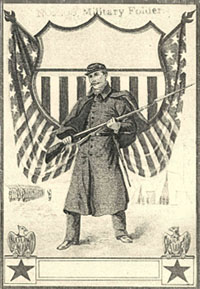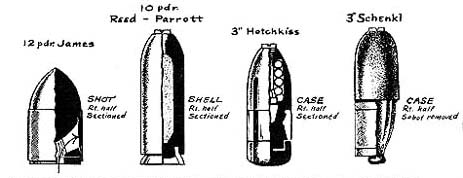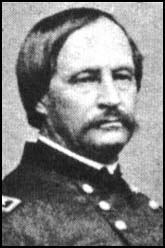 |
In September, 1861, a call was made for volunteers to form a Light Battery to enter the United States service. Immediately the young men from various parts of the State responded to the call and the Battery was filled in a few days. On the 18th of October orders were received to go into camp at Meriden (Hanover village), and on the 26th the men were mustered into the United States service.
On the 13th of January, 1862, orders were received to break camp and march to New Haven. On arriving there it was met by the Second Company Governor's Horse Guard and the Thirteenth Infantry Regiment, and escorted to the steamer "Elm City," on which it proceeded to New York. On January 21st Capt. Alfred P. Bockwell assumed command, and on the same day began to embark the Battery on board the ship "Ellwood Walter."
On Monday, the 27th, at sunrise, the ship sailed from New York harbor bound for Port Royal, S. C.; arrived at Hilton Head February 4th, and the next day proceeded up Broad River to Beaufort, S. C., where the Battery was landed on the 6th of February. On this day the first death occurred among the men - that of private H. B. Bullard. Several days were occupied in disembarking and getting settled in camp. On the 18th of February the first mounted drill took place on Southern soil, and through March and April Captain Rockwell well occupied the Battery on the drill ground until it had become thoroughly instructed in the tactics. May 3d two howitzers arrived from the North for the center section. |
|
May 29th it had its first experience in actual service at Pocotaligo Bridge, S. C., but without loss. The next service was in the movement under Gen. David Hunter, against Charleston, by way of James Island. It took part in the engagements June 2d, 3d, and 14th, also in the attack on the rebel fortified position at Secessionville on the 16th. This last named was one of the most severe battles for the Battery during the war, and although several horses were killed, not a man was injured. For good conduct and well-served guns the Battery was honorably mentioned in General Orders by the commander of the Department of the South.
On the 4th of July the Battery was transferred to Beaufort. September 30th the left section took part in an expedition to Florida, and assisted in the capture of St. John's Bluff.
Nothing more of note occurred until April, 1863, when a second movement was made against Charleston, in which the Battery, although present, took no active part, and soon returned to Beaufort.
In June, one section, without horses, under First Lieut. J. B. Clinton, was embarked on steamer "Governor Milton," and proceeded on an expedition under the command of Colonel Higginson of the First South Carolina Volunteers (colored), to destroy the railroad bridge over the Pompon River, above Willtown, S. C. The movement was not a success, and on the return the steamer ran aground. As it was impossible to get her off she was set on fire, and the two guns of the Battery were sunk in the river to prevent the enemy from taking them.
Again, in July, 1863, the Battery took part in the third movement against Charleston. On the morning of the 16th the enemy attacked in force, intending a surprise. The attack was handsomely repulsed, and the Battery was highly complimented by General Terry on this occasion. Shortly after this it was transferred to Folly Island, where for nine months it formed a part of the reserve forces under General Gilmore at the siege of Charleston.
While on Folly Island forty-six of the men re-enlisted as veterans - December, 1863. |
|
April 18, 1864, it embarked on the transports "General Meigs" and "Ella Knight," bound for Fort Monroe, Va., where it arrived on the 22d, and encamped for a few days at Gloucester Point. There the surplus baggage was stored, and on May 4th the Battery started to join General Butler's forces at Bermuda Hundred, on the James River.
On May 10th it was engaged in the battle of Chester Station, Va. On the 13th it was called into action near the Half-way House, on the Richmond and Petersburg turnpike. On the next day, May 14th, occurred the battle of Proctor's Creek. In this engagement Lieut. George Metcalf and Private Wilmot were killed, ten men were wounded, and ten horses killed. It was also in action at the same place on the 15th and 16th.
It was during one of these battles that a gun-carriage wheel was hit by a rebel shell. The wheel is now in the Battle Flag corridor of the State Capitol at Hartford. After the short and sharp campaign the Battery retired to the entrenchments at Bermuda Hundred. It remained there for six weeks, engaged in the battle of Ware Bottom Church, under General Terry. It moved from thence to Deep Bottom, and from there to the intrenchments in front of Petersburg, where it remained from Aug. 30th to Sept. 23d, during which time hardly a day or night passed in which it was not engaged with the enemy. |
|
|
|
Sept. 27th it moved with the Tenth and Eighteenth Corps across the James River, and was stationed near Port Harrison. Here it was transferred to the Light Artillery Brigade, Twenty-fifth Army Corps, under General Weitzel. It was now in front of Richmond. Near Chapin's Bluff on the 7th of October, at the Darbytown road on the 13th, and at the Charles City road on the 27th, the Battery was also engaged in some sharp fighting. |
|
In November the six-pounder James rifles were exchanged for light twelve-pounder Napoleon guns, because it was almost impossible to get ammunition for the rifled guns. The winter was enlivened occasionally with some skirmishes, yet not much solid work was done, but with the advent of April there was business on hand. |
 |
|
On the 2d of April, 1865, orders were issued, to attack the enemy's lines near Fort Buchanan at daybreak the following morning. Near midnight, however, the plan of attack was modified, as it was thought that the enemy was preparing to abandon the defense of Richmond. Soon heavy and repeated explosions, and the sight of bright fires, confirmed the suspicion, and at daylight the Battery moved with the Twenty-fifth Corps through and over the enemy's works "On to Richmond." Early in the forenoon we entered the city, amid burning buildings and the explosion of shells at the arsenal, which was on fire.
While in the city the glad news came of the capture of Lee and his army, and the war was ended. In a few days the Battery was ordered to Petersburg, then May 3d to City Point.
About June 1st it was moved to Manchester, near Richmond, where, on the 11th day of June, 1865, the men were mustered out of the United States service; the horses, guns, and stores were turned over to the government officers at Richmond, and on Monday morning, June 12th, the men started for Connecticut, arriving at New Haven on the 14th - the first of the veteran troops to return to the State.
The war record of the First Light Battery is one of which no man feels ashamed. The well-merited praise which they received from regular as well as volunteer officers was very gratifying. It was frequently selected from the Artillery Brigade to fire over our skirmishers, and few batteries did more of this difficult work than the First Connecticut Light Battery. General Terry once said of it: "I will not say it is the best battery in the service, but I will say it is the best I have ever seen." |
|
|
On the department review, General Hunter, commander of the Department of the South, expressed his surprise at the fine appearance of it, and said he was not aware that he had so good a battery in his department. |
ENGAGEMENTS
Pocotaligo, S. C., May 28, 1862.
James Island, S. C., June 3, 4, 15, 16, 1862.
Fort Finnegan, Fla., Oct. 8, 1862.
Willtown, S. C., July 10, 1863.
James Island, S. C., July 16, 1863.
James Island, S. C; Feb. 10, 1864.
Chester Station, Va., May 10, 1864.
Richmond Turnpike, Va., May 12, 1864.
Proctor's Creek, Va., May 15, 1864.
Drewry's Bluff, Va., May 16, 1864.
Bermuda Hundred, Va., May 17 to June 27, 1864.
Grover House, Va., May 27, 1864.
Wire Bottom Church, Va., June 16, 1864.
Strawberry Plains, Va., June 26, 1864.
Four Mile Creek, Va., Aug. 14, 1864.
Deep Bottom, Va., Aug. 27, 1864.
Petersburg, Va., Aug. 25 to Sept. 25, 1864.
Chapin's Bluff, Va., Oct. 7, 1864.
Johnnon's Farm, Va., Oct. 13, 27, 28, 1864.
Richmond, Va., October, 1864, to April, 1865.
Casualties First C. V. Light Battery
|
Killed |
Wounded |
Died |
Discharged Disabled |
Total |
|
2 |
13 |
20 |
4 |
39 |
Editor’s Note: This is the seventh monthly installment of the history of Connecticut’s service in the Civil war, as published in the RECORD OF SERVICE OF CONNECTICUT MEN IN THE WAR OF REBELLION, 1861 TO 1865. (Transcribed by Staff Sergeant Brett W. Wilson, Administrative Assistant to the USPFO for Connecticut).





